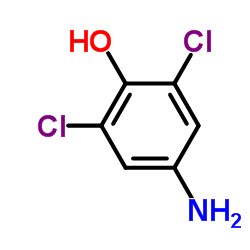In vivo and in vitro 4-amino-2,6-dichlorophenol nephrotoxicity and hepatotoxicity in the Fischer 344 rat.
G O Rankin, M A Valentovic, D W Nicoll, J G Ball, D K Anestis, R T Wang, P I Brown
Index: Toxicology 90(1-2) , 115-28, (1994)
Full Text: HTML
Abstract
Halogenated anilines and aminophenols are nephrotoxicants and hepatotoxicants in mammals. The purpose of this study was to determine the in vivo and in vitro nephrotoxic and hepatotoxic potential of 4-amino-2,6-dichlorophenol, a putative metabolite of 3,5-dichloroaniline. In the in vivo experiments, male Fischer 344 rats (four/group) were administered a single intraperitoneal (i.p.) injection of 4-amino-2,6-dichlorophenol (0.25, 0.38 or 0.50 mmol/kg) or vehicle (dimethylsulfoxide (DMSO), 1.0 ml/kg) and renal and hepatic function monitored for 48 h. Only minor changes in function or morphology were observed in the 0.25 mmol/kg treatment group. However, in the 0.38 mmol/kg treatment group evidence of both nephrotoxicity and hepatotoxicity were evident. Nephrotoxicity was characterized by increased proteinuria, glucosuria, hematuria, elevated blood urea nitrogen (BUN) concentration and kidney weight, decreased p-aminohippurate (PAH) accumulation and proximal tubular necrosis in the corticomedullary region of the kidney. Hepatotoxicity was characterized by elevated plasma alanine aminotransferase (ALT/GPT) activity and liver weight. Animals administered the 0.5 mmol/kg dose died within 24 h. In the in vitro experiments, the effect of 4-amino-2,6-dichlorophenol on organic ion accumulation, gluconeogenesis and lactate dehydrogenase (LDH) leakage was quantitated in liver and/or renal cortical slices. Organic anion accumulation was inhibited in renal cortical slices by 4-amino-2,6-dichlorophenol bath concentrations of 5 x 10(-6) M or higher, while organic cation uptake was decreased at 4-amino-2,6-dichlorophenol bath concentrations of 1 x 10(-5) M or greater. Renal and hepatic pyruvate-stimulated gluconeogenesis were inhibited and renal LDH leakage increased at 4-amino-2,6-dichlorophenol bath concentrations of 5 x 10(-5) M or greater. Increased LDH leakage from liver slices was not observed. These results demonstrate that 4-amino-2,6-dichlorophenol is a nephrotoxicant and hepatotoxicant in vivo and in vitro and that the kidney is more susceptible to 4-amino-2,6-dichlorophenol toxicity than the liver.
Related Compounds
| Structure | Name/CAS No. | Molecular Formula | Articles |
|---|---|---|---|
 |
4-Amino-2,6-dichlorophenol
CAS:5930-28-9 |
C6H5Cl2NO |
|
Characterization of methemoglobin formation induced by 3,5-d...
1997-03-14 [Toxicology 118(1) , 23-36, (1997)] |
|
Fluorescent materials for pH sensing and imaging based on no...
2013-09-28 [J. Mater. Chem. C 1 , 5685-5693, (2013)] |
|
Theory and practice of enzyme bioaffinity electrodes. Chemic...
2008-06-11 [J. Am. Chem. Soc. 130(23) , 7276-85, (2008)] |
|
Theory and practice of enzyme bioaffinity electrodes. Direct...
2008-06-11 [J. Am. Chem. Soc. 130(23) , 7259-75, (2008)] |
|
4-Amino-2,6-dichlorophenol nephrotoxicity in the Fischer 344...
1997-11-01 [Toxicol. Appl. Pharmacol. 147(1) , 115-25, (1997)] |